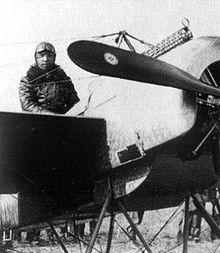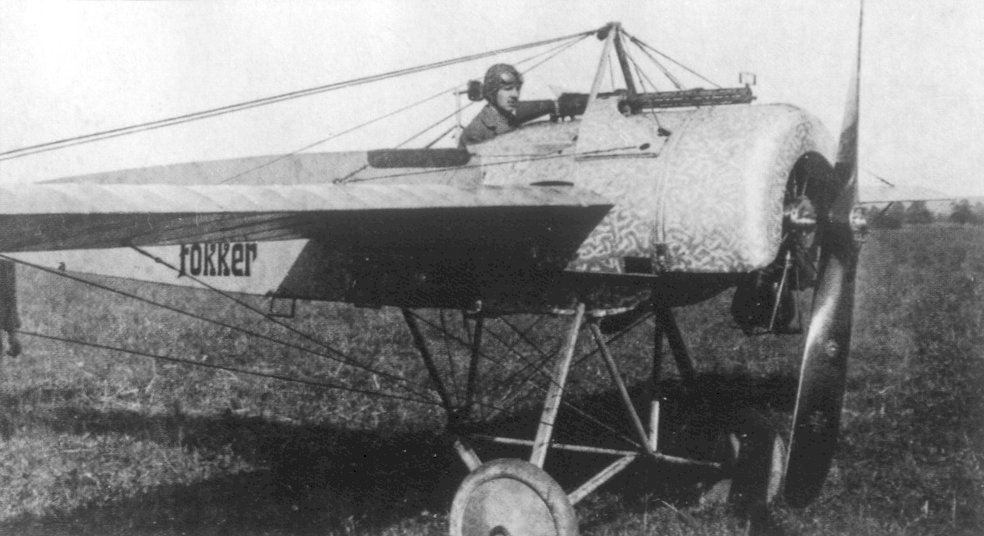
Lt Max Immelmann ja Fokker E2.37/15 (1915)
When World War I started, Immelmann was called to active service, transferred to Die Fliegertruppe (later known as the Luftstreitkräfte ) and was sent for pilot training at Johannisthal Air Field in November 1914. He was initially stationed in northern France .
Immelmann served as a pilot with Feldflieger Abteilung (Field Flier Detachment) 10 from February to April 1915, and then in FFA 62 by early May 1915. On several occasions he engaged in combat while flying the LVG two-seaters with which his units were equipped, but never with any success. On 3 June 1915, he was shot down by a French pilot but managed to land safely behind German lines. Immelmann was decorated with the Iron Cross, Second Class for preserving his aircraft.
Silver beaker given to Immelmann, Bundeswehr Military History Museum
Two very early examples of the Fokker Eindeckers were delivered to the unit, one Fokker M.5K/MG production prototype numbered E.3/15 for Oswald Boelcke 's use, with Immelmann later in July receiving E.13/15 as a production Fokker E1 for his own use before the end of July. It was with the E.13/15 aircraft, armed with the synchronized lMG 08 machine gun, that he gained his first confirmed air victory of the war on 1 August 1915, a fortnight after Leutnant Kurt Wintgens obtained the very first confirmed German aerial victory on 15 July 1915 with his own Fokker M.5K/MG production prototype E.5/15 Eindecker, one of five built, following two unconfirmed ones on July 1 and 4, all before Immelmann.

"Like a hawk, I dived... and fired my machine gun. For a moment, I believed I would fly right into him. I had fired about 60 shots when my gun jammed. That was awkward, for to clear the jam I needed both hands - I had to fly completely without hands"

Lieutenant William Reid fought back valiantly, flying with his left hand and firing a pistol with his right. Nonetheless, the 450 bullets fired at him took their effect; Reid suffered four wounds in his left arm, and his airplane's engine quit, causing a crash landing. The unarmed Immelmann landed nearby, and approached Reid; they shook hands and Immelmann said to the British pilot "You are my prisoner" and pulled Reid out of the wreckage and rendered first aid.
Immelmann became one of the first German fighter pilots, quickly building an impressive score of air victories. During September, three more victories followed, and then in October he became solely responsible for the air defense of the city of Lille. Immelmann became known as The Eagle of Lille (Der Adler von Lille).
Immelmann flirted with the position of Germany's leading ace, trading that spot off with another pioneer ace, Oswald Boelcke. Having come second to Boelcke for his sixth victory, he was second to be awarded the Royal House Order of Hohenzollern for this feat. On 15 December, Immelmann shot down his seventh British plane and moved into an unchallenged lead in the competition to be Germany's leading ace.
Max Immelmann's Fokker E.II in late October 1915
Immelmann was the first pilot to be awarded the Pour le Mérite , Germany's highest military honour, receiving it on the day of his eighth win, 12 January 1916 The medal became unofficially known as the "Blue Max" in the German Air Service in honor of Immelmann. His medal was presented by Kaiser Wilhelm II on 12 January 1916. Oswald Boelcke received his medal at the same time.
Boelcke scored again two days later. Immelmann would chase him in the ace race for the next four months, drawing even on 13 March at 11 each, losing the lead on the 19th, regaining it on Easter Sunday (23 April) 14 to 13, losing it again forever on 1 May. It was about this time, on 25 April, that Immelmann received a salutary lesson in the improvement of British aircraft. As the German ace himself described his attack on two Airco DH.2s , "The two worked splendidly together...and put 11 shots into my machine. The petrol tank, the struts on the fuselage, the undercarriage and the propeller were hit... It was not a nice business."
On 31 May, Immelmann, Max von Mulzer , and another German pilot attacked a formation of seven British aircraft. Immelmann was flying a two-gun Fokker E.IV , and when he opened fire, the synchronizing gear malfunctioned. A stream of bullets cut off the tip of a propeller blade. The thrashing of the unbalanced air screw nearly shook the aircraft's Oberursel engine loose from its mounts before he could cut the ignition and glide to a dead-stick landing.

----------
In the late afternoon of 18 June 1916, Immelmann led a flight of four Fokker E.III Eindeckers in search of a flight of eight FE2b reconnaissance aircraft of 25 Squadron Royal Flying Corps over Sallaumines in northern France. The British flight had just crossed the lines near Arras, with the intent of photographing the German infantry and artillery positions within the area, when Immelmann's flight intercepted them. After a long-running fight, scattering the participants over an area of some 30 square miles, Immelmann brought down one of the enemy aircraft, wounding both the pilot and observer. This was his 16th victory claim, though it was to go unconfirmed.

At 21:45 that same evening, Immelmann in Fokker E.III, serial 246/16 encountered No. 25 Squadron again, this time near the village of Lens. Immediately, he got off a burst which hit RFC Lt. JRB Savage, pilot of FE.2b pusher serial 4909, mortally wounding him. This was his 17th victory claim, though Max Mulzer was later credited with the victory. The crew of the second aircraft he closed on was piloted by Second Lieutenant GR McCubbin with Corporal JH Waller as gunner/observer, and was credited by the British with shooting Immelmann down. On the German side, many had seen Immelmann as invincible and could not conceive the notion that he had fallen to enemy fire. Meanwhile, British authorities awarded McCubbin the Distinguished Service Order and the Distinguished Service Medal and sergeant's stripes for Waller.
The German Air Service at the time claimed the loss was due to (friendly) anti-aircraft fire. Others, including Immelmann's brother, believed his aircraft's gun synchronisation (designed to enable his machine gun to fire between the whirling propeller blades without damaging them) had malfunctioned with catastrophic results. This is not in itself unreasonable, as early versions of such gears frequently malfunctioned in this way. Indeed, this had already happened to Immelmann twice before (while testing two- and three-machine gun installations), although on each occasion, he had been able to land safely. McCubbin, in a 1935 interview, claimed that immediately after Immelmann shot down McCubbin's squadron mate, the German ace began an Immelmann turn, McCubbin and Waller swooped down from a greater altitude and opened fire, and the pioneer German ace fell out of the sky. Waller also pointed out later that the British bullets could have hit Immelmann's propeller.
Damage to the propeller resulting in the loss of one blade could have been the primary cause of the structural failure evident in accounts of the crash of his aircraft. The resultant vibration of an engine at full throttle spinning half a propeller could have shaken the fragile craft to pieces. At 2,000 meters, the tail was seen to break away from the rest of Immelmann's Fokker, the wings detached or folded, and what remained of the fuselage fell straight down, carrying the 25-year-old Oberleutnant to his death. His body was recovered by the German 6 Armee from the twisted wreckage, lying smashed and lifeless over what was left of the surprisingly intact Oberursel engine (sometimes cited as under it), but was only identified because he had his initials embroidered on his handkerchief.
Immelmann was given a state funeral and buried in his home of Dresden . His body was later exhumed, however, and cremated in the Dresden-Tolkewitz Crematorium.
Legacy
The present-day Luftwaffe has dubbed Squadron AG-51 the "Immelmann Squadron" in his honour.
hi, good work!, enjoying your blog very much!
VastaaPoistaHello, and thanks for your comment.
PoistaThe situation has slightly to expand my original plan.
My original idea was to write only the FAF and the pilots,
but i have are too few topics in english, so, here I am...